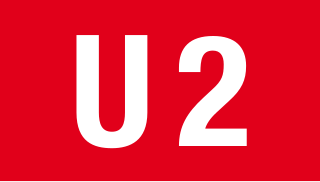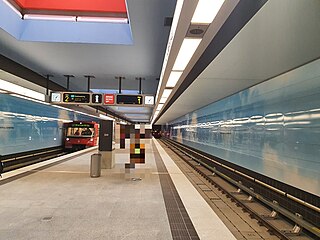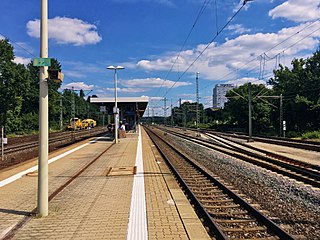
A ghost station is a disused train station through which revenue-service passenger trains pass but at which they do not stop. The term is also sometimes used for any unused underground station or any unused station, whether or not trains pass through them. In Germany, a station that has been built in the course of constructing something else as a so-called "Bauvorleistung" is referred to as a "ghost station", despite the different purpose and origin of the terms. Some English-language publications also refer to "pre-built" stations or parts thereof that have yet to see service as "ghost stations".

The Nuremberg U-Bahn is a rapid transit system run by Verkehrs-Aktiengesellschaft Nürnberg, which itself is a member of the Verkehrsverbund Großraum Nürnberg. The Nuremberg U-Bahn is Germany's newest metro system, having begun operation in 1972, although the Nuremberg-Fürth route (U1) uses part of the right of way of the Bavarian Ludwig Railway, Germany's first passenger railway opened in 1835. The current network of the U-Bahn is composed of three lines, serving 49 stations, and comprising 38.2 kilometres (23.7 mi) of operational route, making it the shortest of the four metro systems in Germany, behind Berlin, Hamburg and Munich.

Flughafen station is a Nuremberg U-Bahn station, located on the U2, serving Nuremberg Airport. Since 2008 when Berlin Tempelhof Airport shut down, Nuremberg has been the only city in Germany whose airport is connected to the subway network.

Rothenburger Straße station is a Nuremberg U-Bahn station, located on the U2 and U3. When traveling in a southerly direction it is the last station to be served by both U2 and U3. The station is connected to the Nürnberg Rothenburgerstraße station of the Nuremberg S-Bahn.

Nürnberg Hauptbahnhof or Nuremberg Central Station is the main railway station serving the city of Nuremberg in Germany. It is the largest station in north Bavaria and belongs to the 20 stations in the highest category of importance allocated by DB Station&Service.

Fürth (Bayern) Hauptbahnhof is a railway hub for the city of Fürth in Bavaria, Germany. The station is mainly frequented by regional services. It also has a connection to the Nuremberg U-Bahn (underground) system and the Nuremberg S-Bahn (commuter) network.

The station Nürnberg Nordost, colloquial form Nordostbahnhof, is a railway station in Nuremberg, Germany. It is a terminal station, providing a link to Gräfenberg, as the line to Gräfenberg has no connection to Nürnberg Hauptbahnhof, the city's main station.

The Cologne Stadtbahn is a light rail system in the German city of Cologne, including several surrounding cities of the Cologne Bonn Region. The term Stadtbahn denotes a system that encompasses elements of trams as well as an underground railway network (U-Bahn) and interurban rail, even including three lines that are licensed as heavy rail and used by freight trains as well as Stadtbahn vehicles. Two of these lines connect the Cologne Stadtbahn to the Bonn Stadtbahn. These lines are jointly operated by both cities' transport authorities, resulting in both systems and the lines connecting them sometimes collectively referred to as Stadtbahn Rhein-Sieg.

Französische Straße was a Berlin U-Bahn underground station on the U6 line located under the street Friedrichstraße in central Berlin.

Friedrich-Ebert-Platz station is a Nuremberg U-Bahn station. It was the northern terminus of the U3 line from its opening on 10 December 2011 until 2017, when the extension towards Nordwestring opened. It offers interchange to Tramway line 4. Like Aufseßplatz, Hauptbahnhof and Plärrer orange tiles were used in the walls of this station to indicate a possible future interchange station. However, as of 2021 no such interchange to another subway line is planned for the foreseeable future.

The U1 is an underground line in Nuremberg. The first part of the line was opened on 1 March 1972. It is about 18.5 kilometres (11.5 mi) long and has 27 stations. The termini are Langwasser Süd in the southeast and Fürth Hardhöhe in the northwest. Until 11 December 2016 it shared tracks with the former booster line U11 between Eberhardshof and Messe. Those services are still run but no longer designated U11, instead being signed U1 like trains doing the full Langwasser-Hardhöhe run. Unlike U2 and U3 all trains are operated by a driver and there are no plans to automate U1.

The U2 is an underground line in Nuremberg, opened on 28 January 1984 and the last station along the line to open was Flughafen (Airport) in 1999. The line is about 13.1 kilometres (8.1 mi) long and has 16 stations; the termini are Röthenbach and Flughafen. Since 2010 all trains in regular operations are run driverless. At 2,388 metres (7,835 ft) the stretch between Ziegelstein station and Flughafen station is the longest interval between two stations in the network and the only single track section on any subway line in Germany.

The U3 is an underground line in Nuremberg. The line was opened on 14 June 2008. It is about 9.2 kilometres (5.7 mi) long, making it the shortest in the system. The number of stations is 14. The termini are Nordwestring and Großreuth. U 3 trains are run driverless and have been since the opening of the line. U3 shares part of its route with the older U2. Due to the circuitous horseshoe-shaped route, U3 is not always the fastest public transit option between its stations. For example, the buses that run along B4R are - per the official schedules - faster for getting from Nordwestring to Gustav Adolf Straße and the tramway line 4 is faster for getting from Friedrich Ebert Platz to Plärrer than the respective U3 connection.

The Nuremberg-Bamberg line is a German railway connecting the Bavarian city of Nuremberg with Bamberg via Fürth, Erlangen, Forchheim. It is part of the northern section of the Ludwig South-North Railway. It runs along the Regnitz Valley and is one of the important German transport routes. Since 2010 line S1 of the Nuremberg S-Bahn uses the entirety of the line from Nuremberg to Bamberg.

The Nuremberg tramway network is a network of tramways forming part of the public transport system in Nuremberg, a city in the federal state of Bavaria, Germany. The system reached the neighboring city of Fürth from its opening year to almost a century later when construction of the U1 subway line led to the withdrawal of tram service to and within Fürth. During that era and referring to it historically in literature or nostalgic activities, the system was known as “Nürnberg-Fürther Straßenbahn“. For example, a local association dedicated to preserving the history and heritage of the tram network as well as old rolling stock calls itself “Freunde der Nürnberg-Fürther Straßenbahn“ The system is planned to cross the municipal boundaries of Nuremberg once more, if and when the extension to Erlangen and from there to Herzogenaurach dubbed "Stadtumlandbahn" opens.

Treuchtlingen station is now the only station in the town of Treuchtlingen in the German state of Bavaria. The town used also to have stations at Graben, Möhren, Gundelsheim and Wettelsheim. Treuchtlingen station has seven platform tracks and it is classified by Deutsche Bahn as a category 3 station. The station is served by about 110 trains daily operated by DB Regio and DB long-distance. The station is a railway junction on the Treuchtlingen–Nuremberg, Donauwörth–Treuchtlingen, Ingolstadt–Treuchtlingen and Treuchtlingen–Würzburg lines.
The Nuremberg–Feucht railway is a 12.5-kilometre (7.8 mi)-long main-line railway in the German state of Bavaria, running from Nuremberg Hauptbahnhof to Feucht. It was built parallel with the Nuremberg–Regensburg railway during the first construction phase of the Nuremberg S-Bahn and opened on 21 November 1992.

Nordostbahnhof station is the 34th underground station of the Nuremberg U-Bahn and was opened on 27 January 1996. It is 902m from Schoppershof underground station and 835m from Herrnhütte underground station. The station is connected to Rottenbach by a sharp track change and a parking and sweeping facility in the direction of the airport up to Herrnhütte underground station. The Nordostbahnhof was opened on 1 February 1908 as part of the Gräfenbergbahn. According to earlier plans, the station was to be called Leipziger Platz.

Großreuth bei Schweinau station is a Nuremberg U-Bahn station, located on the U3. Named for the borough Großreuth bei Schweinau. The distance to the previous station, Gustav Adolf Straße is 898 metres (2,946 ft) as the crow flies. Opening in October 2020, it was the 49th station of Nuremberg U-Bahn to open and serves as the terminus for line U3 until the opening of further extensions towards Gebersdorf.

Nürnberg Frankenstadion station is a railway station in Nuremberg, Germany. It is located along the Nuremberg–Feucht railway, between the Zerzabelshof district in the north and Volkspark Dutzendteich in the south. It is served by the S2 of the Nuremberg S-Bahn.























